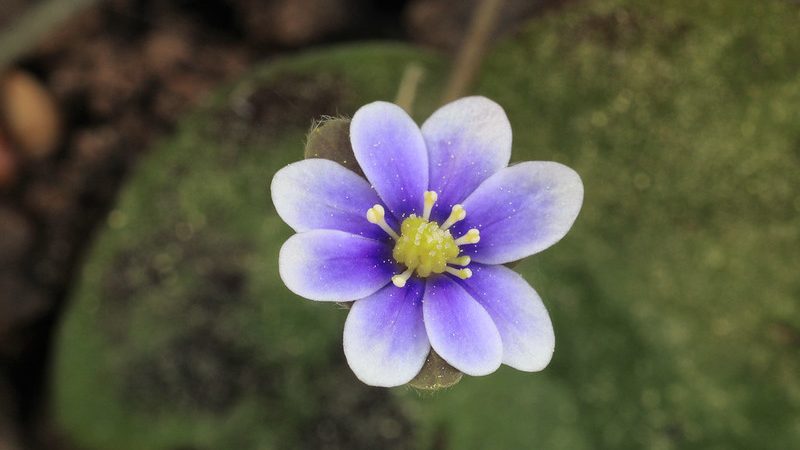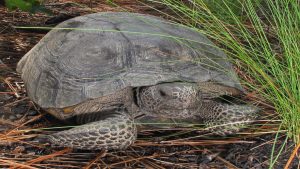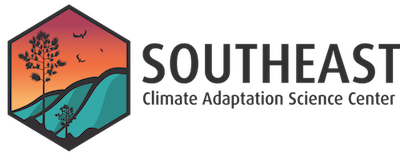March 2022 Newsletter

March 2022 Newsletter
Welcome to the Southeast Climate Adaptation Science Center’s March 2022 Newsletter.
For news and upcoming events related to the Southeast Climate Adaptation Science Center,
subscribe to our monthly newsletter.
SE CASC News | Resources | Publications | Tribal News | Partner News | Webinars | Events | Opportunities

Southeast Climate Adaptation Science Center News
Save the Date! The 2022 SE CASC Regional Science Symposium is rescheduled for Sept. 19-21, 2022, in Gulf Shores, AL. Stay tuned for reopening of registration and call for abstracts for the Poster/Tools Networking session.
Don’t miss our next virtual Science Seminar TODAY, March 22, 1 pm ET, Incorporating the Benefits of Natural and Working Lands in Conservation Planning, presented by Katie Warnell, Duke University. Learn more and register for the seminar.
SE CASC Global Change Fellows are hosting a Global Change Seminar and mini-workshop, Why Framing Matters: Tools for More Inclusive Climate Change Communication, given by Kayla McCurry, National Network for Ocean and Climate Change Interpretation, on March 29, 3:30 pm ET. Learn more and register for the event.
Mark your calendar for the second Global Change Seminar of the semester, a double header focused on freshwater streams and climate, featuring a film screening April 7 at 5:30pm and panel discussion on April 8 at 2 pm. More details and registration are forthcoming.
Researcher Spotlights: Learn about Global Change Fellows Madeline Anderson and Lauren Pharr.
SE CASC-supported publication, Predicting flood damage probability across the conterminous United States, uses machine learning and open source data to map predictions of flood damage probability. A product of project, Improving Scenarios of Future Patterns of Urbanization, Climate Adaptation, and Landscape Change in the Southeast, co-authors included Faculty Affiliates, Georgina Sanchez and Ross Meentemeyer and Research Ecologist Adam Terando. Learn more.
USGS Deputy Director, Ryan Boyles co-authored Potential Effects of Climate Change on Snail Kites (Rostrhamus sociabilis plumbeus) in Florida.
2019-20 Global Change Fellow, Mario Simon Pinella-Gallego authored and University Director, Becky Irwin co-authored, Effects of an alternative host on the prevalence and intensity of infection of a bumble bee parasite.
2019-20 Global Change Fellow, Katie McQuillan is lead author to Forest water use is increasingly decoupled from water availability even during severe droughts with co-authors Faculty Affiliates, Mirela Tulbure and Katherine Martin. Read more.
2018-19 Global Change Fellow, Tina Mozelewski, published Forecasting the influence of conservation strategies on landscape connectivity, co-authored by Faculty Affiliate Robert Scheller. Read Tina’s post.
Faculty Affiliates, Elsa Youngsteadt and Jaime Collazo are co-authors to Estimating bee abundance: can mark-recapture methods validate common sampling protocols?. Read more.
Conservation Corridor: Increased temperatures lead to decreased connectivity in coral reefs.
Project Spotlight
 Providing Science for the Conservation of Animals in the Southeastern Longleaf Pine Ecosystem
Providing Science for the Conservation of Animals in the Southeastern Longleaf Pine EcosystemThe longleaf pine ecosystem in the southeastern U.S. supports several at-risk species that are currently undergoing status reviews by the U.S. Fish and Wildlife Service to determine if they are threatened or endangered due to habitat loss and other threats. The work focused on five reptile and amphibian species: gopher tortoise, gopher frog, striped newt, southern hognose snake, and Florida pine snake. The project used a collaborative approach with Federal, State, and other partners to assess current habitat conditions and population trends of each species and to predict risk of species extinction under future threats and management options. They contributed to the official Species Status Assessment for the southern hognose snake and co-developed a decision-making framework for gopher frog conservation, informing effective conservation strategies and status designation decisions.The project was led by SE CASC Principal Investigator Clint Moore. Learn more.
Resources
Climate Change 2022: Impacts, Adaptation and Vulnerability. The Working Group II contribution to the IPCC Sixth Assessment Report assesses the impacts of climate change, looking at ecosystems, biodiversity, and human communities at global and regional levels. It also reviews vulnerabilities and the capacities and limits of the natural world and human societies to adapt to climate change. Learn more.
Global and Regional Sea Level Rise Scenarios for the United States: Updated Mean Projections and Extreme Water Level Probabilities Along U.S. Coastlines. The U.S. Sea Level Rise and Coastal Flood Hazard Scenarios and Tools Interagency Task Force published updated sea level rise projections out to 2150 and extreme water level probabilities for the Nation’s coasts out to year 2050. This effort offers information to help coastal communities prepare for the impacts of sea level rise. Learn more.
Biodiversity at Risk: Today’s Choices Matter. National Academy of Sciences, Engineering, & Medicine published this booklet, produced by an international committee of experts, providing an overview of the many dimensions of biodiversity and why it’s vital to the health of all life on the planet. It also examines the causes of biodiversity loss and presents actions that can be taken from the individual to the global level to stop this decline. Learn more.
Coastal County Snapshots. NOAA developed this visual tool designed to help people understand complex, county-level information related to coastal resilience, and use this information to ensure future safety, a healthy environment, and a vibrant economy. Learn more.
Survival by Degrees: 389 Bird Species on the Brink. Audubon Society developed this tool that utilized 140 million bird observations by birders and scientists, to describe the current ranges of 604 North American bird species. They then used the latest climate models to project how each species’s range will shift as climate change and other human impacts advance across the continent. Learn more.
In the Media
On the trail of a pirate In Louisiana’s disappearing wetlands. Aljazeera
Latest IPCC Report Marks Progress on Climate Justice. Inside Climate News
Birder to Birder. Emergence Magazine
Five Artworks for Talking about Climate Change. National Gallery of Art.
Notable Publications
Targeting current species ranges and carbon stocks fails to conserve biodiversity in a changing climate: opportunities to support climate adaptation under 30 × 30. Journal Abstract. Protecting areas for climate adaptation will be essential to ensuring greater opportunity for species conservation well into the future. However, many proposals for protected areas expansion focus on our understanding of current spatial patterns, which may be ineffective surrogates for future needs. A science-driven call to address the biodiversity and climate crises by conserving at least 30% of lands and waters by 2030, 30 × 30, presents new opportunities to inform the siting of new protections globally and in the US. Here we identify climate refugia and corridors based on a weighted combination of currently available models; compare them to current biodiversity hotspots and carbon-rich areas to understand how 30 × 30 protections siting may be biased by data omission; and compare identified refugia and corridors to the protected areas database to assess current levels of protection. Available data indicate that 20.5% and 27.5% of identified climate adaptation areas (refugia and/or corridor) coincides with current imperiled species hotspots and carbon-rich areas, respectively. With only 12.5% of climate refugia and corridors protected, a continued focus on current spatial patterns in species and carbon richness will not inherently conserve places critical for climate adaptation. However, there is ample opportunity for establishing future-minded protections: 52% of the contiguous US falls into the top quartile of values for at least one class of climate refugia. Nearly 27% is already part of the protected areas network but managed for multiple uses that may limit their ability to contribute to the goals of 30 × 30. Additionally, nearly two-thirds of nationally identified refugia coincide with ecoregion-specific refugia suggesting representation of nearly all ecoregions in national efforts focused on conserving climate refugia. Based on these results, we recommend that land planners and managers make more explicit policy priorities and strategic decisions for future-minded protections and climate adaptation. Link to article.
Detecting Coastal Wetland Degradation by Combining Remote Sensing and Hydrologic Modeling. Journal Abstract. Sea-level rise and climate change stresses pose increasing threats to coastal wetlands that are vital to wildlife habitats, carbon sequestration, water supply, and other ecosystem services with global significance. However, existing studies are limited in individual sites, and large-scale mapping of coastal wetland degradation patterns over a long period is rare. Our study developed a new framework to detect spatial and temporal patterns of coastal wetland degradation by analyzing fine-scale, long-term remotely sensed Normalized Difference Vegetation Index (NDVI) data. Then, this framework was tested to track the degradation of coastal wetlands at the Alligator River National Wildlife Refuge (ARNWR) in North Carolina, United States, during the period from 1995 to 2019. We identified six types of coastal wetland degradation in the study area. Most of the detected degradation was located within 2 km from the shoreline and occurred in the past five years. Further, we used a state-of-the-art coastal hydrologic model, PIHM-Wetland, to investigate key hydrologic processes/variables that control the coastal wetland degradation. The temporal and spatial distributions of simulated coastal flooding and saltwater intrusion confirmed the location and timing of wetland degradation detected by remote sensing. The combined method also quantified the possible critical thresholds of water tables for wetland degradation. The remote sensing–hydrologic model integrated scheme proposed in this study provides a new tool for detecting and understanding coastal wetland degradation mechanisms. Our study approach can also be extended to other coastal wetland regions to understand how climate change and sea-level rise impact wetland transformations. Link to article.
Urban climate resilience through hybrid infrastructure. Journal Abstract. Urban infrastructure will require transformative changes to adapt to changing disturbance patterns. We ask what new opportunities hybrid infrastructure—built environments coupled with landscape-scale biophysical structures and processes—offer for building different layers of resilience critical for dealing with increased variation in the frequency, magnitude and different phases of climate-related disturbances. With its more diverse components and different internal logics, hybrid infrastructure opens up alternative and additive ways of building resilience for and through critical infrastructure, by providing a wider range of functions and responses. Second, hybrid infrastructure points toward greater opportunities for ongoing (re)design at the landscape level, where structure and function can be constantly renegotiated and recombined. Link to article.
A Hydrologist’s Guide to Open Science. Journal Abstract. Open, accessible, reusable, and reproducible hydrologic research can have a significant impact on the scientific community and broader society. While more individuals and organizations within the hydrology community are embracing open science practices, technical (e.g., limited coding experience), resource (e.g., open access fees), and social (e.g., fear of being scooped) challenges remain. Furthermore, there are a growing number of constantly evolving open science tools, resources, and initiatives that can seem overwhelming. These challenges and the ever-evolving nature of the open science landscape may seem insurmountable for hydrologists interested in pursuing open science. Therefore, we propose general Open Hydrology Principles to guide individual and community progress toward open science for research and education and the Open Hydrology Practical Guide to improve the accessibility of currently available tools and approaches. We aim to inform and empower hydrologists as they transition to open, accessible, reusable, and reproducible research. We discuss the benefits as well as common open science challenges and how hydrologists can overcome them. The Open Hydrology Principles and Open Hydrology Practical Guide reflect our knowledge of the current state of open hydrology; we recognize that recommendations and suggestions will evolve and expand with emerging open science infrastructures, workflows, and research experiences. Therefore, we encourage hydrologists all over the globe to join in and help advance open science by contributing to the living version of this document and by sharing open hydrology resources in the community-supported repository (https://open-hydrology.github.io). Link to article.
Face-off: Novel depredation and nest defense behaviors between an invasive and a native predator in the Greater Everglades Ecosystem, Florida, USA. Journal Abstract. We describe several photo-documented novel interactions between intraguild predators in southern Florida—the native bobcat (Lynx rufus) and the invasive Burmese python (Python bivittatus). Over several days we documented a bobcat’s depredation of an unguarded python nest and subsequent python nest defense behavior following the return of both animals to the nest. This is the first documentation of any animal in Florida preying on python eggs, and the first evidence or description of such antagonistic interactions at a python nest. Link to article.
Tribal News
Visit USET Climate Change Headlines for updates on information regarding climate science events, funding opportunities, best practices, and highlights from across the USET region.
Department of Interior is hosting Tribal College and Universities Event: Roadmap to a Career at the Department of the Interior on April 6-7, 2022, 12PM – 4:30PM ET. Topics covered include: Navigating USA Jobs, Interview Techniques, Resume Building, Careers opportunities at DOI (Internships & jobs), Hiring Authority. Register.
National Tribal and Indigenous Climate Change conference, being held Aug. 29 – Sep. 1, in St. Paul, MN and online, is accepting proposals for conference tracks to discuss climate-related impacts, assessments, tools, adaptation, mitigation, actions, and the intersection of western science and adaptation strategies with Traditional/Indigenous Knowledges. Get more information and submit by April 22.
Water and Land Summer Internship Program provides the opportunity for students to gain hands-on skills with tribal environmental offices or other organizations managing water and land resources. Spring 2022 full-time Native American students are eligible. Apply here by April 29.
Applications for Tribal Nation teams are being accepted for USET Tribal Climate Resilience Camp, July 10-15. Priority will be given to 3-member teams who apply by March 31. More details and registration can be found here.

Regional Partner News
- US Fish and Wildlife Service: Interior Department Announces Over $1.5 Billion to Support State Wildlife Conservation and Outdoor Recreation.
- Southeastern Association of Fish and Wildlife Agencies: Ross Melinchuk named the Executive Director of SEAFWA.
- US Army Corps of Engineers: Rivercane Restoration Workshop Summary Report.
- Southeast Conservation Adaptation Strategy: First blog from the new SECAS Coordinator.

Webinars
Find more upcoming events in our calendar.
Mar. 22 | 1pm-2pm | SE CASC Science Seminar: Incorporating the Benefits of Natural and Working Lands in Conservation Planning
Mar. 23 | 11am-12:15pm | Harmful Algal Blooms and Ocean Acidification
Mar. 24 | 1pm-2pm | Fresh Banana Leaves: Healing Indigenous Landscape Through Indigenous Science
Mar. 29 | 2pm-3pm | Practical Applications of Soil Moisture Information
Mar. 29 | 3:30pm-4:30pm | Global Change Seminar – Why Framing Matters: Tools for More Inclusive Climate Change Communication
Mar. 30 | 10:30am-11:30am | Find Your Place in Climate Action
Apr. 7 | 9am-10am | Climate and Conservation Coffee
Apr. 7 | 5:30pm-7pm | Global Change Seminar film screening
Apr. 8 | 2:30pm-7pm | Global Change Seminar panel discussion
Apr. 12 | 10am-11am | Southeast Climate Monthly Webinar
Apr. 19 | 1pm-2pm | Climate Adaptation for Forest-Dependent Wildlife
Webinar Series
Upcoming Events
Apr. 19-20 | 3rd Climate Change in the Caribbean Conference: Promoting Climate Resilience in Puerto Rico & U.S. Virgin Islands | Virtual
Sep. 7 | Understanding Algal Blooms: State of the Science Hybrid Conference 2022 | Toledo, OH
Sep. 19-21 | Southeast CASC Regional Science Symposium | Gulf Shores, AL

Opportunities
Student Announcements
Resilient Nation Partnership Network is accepting applications here for the “Next Generation of Resilience” Student Showcase on the theme, Adapting to Future Risk, due by Mar. 25.
Worldwide Teach-In on Climate and Justice, organized by Bard College, takes place on Mar. 30. Learn more and find a campus event here. NC State’s event information here.
Deep South Center for Environmental Justice is accepting applications for the HBCU Environmental Justice and Climate Corps Internship. Students will work with a partner community based organization disproportionately impacted by environmental hazards and climate change. Get more information and apply here by Apr. 23.
Hiring Announcements
NC Cooperative Institute of Climate Studies is recruiting a post doc in Climate Justice and Community-Driven Epidemiology for the Carolinas Collaborative on Climate, Health, and Equity. Get information and apply here.
National Ecological Observatory Network is hiring seasonal field technicians in Alaska. Apply here or here (lead position.)
USGS and Pacific Islands CASC are seeking applicants for a research opportunity involving Indigenous Pacific Islander and Native Hawaiian climate engagement. Applications are due Apr. 15. Get more details and apply here.
NC Division of Coastal Management has two job openings, both open until April 11: Coastal Resiliency Coordinator (apply here) and Coastal Resiliency Specialist (apply here).
NC State University is hiring for a Data & Visualization Librarian. More information here.
Funding Opportunities
National Coastal Resilience Fund 2022 Request for Proposals is open for funding from National Fish and Wildlife Foundation and NOAA, for planning, design, and restoration of natural and nature-based solutions to help protect coastal communities from the impacts of storms, floods, and other natural hazards and enable them to recover more quickly and enhance habitats for fish and wildlife. Pre-proposals are due April 21; Pre-Proposal Webinar March 30. More information.
Network for Landscape Conservation has released the 2022 Request for Proposals for the Landscape Conservation Catalyst Fund, to accelerate the pace and practice of collaborative landscape conservation across the United States. A portion of the Catalyst Fund is dedicated to supporting Indigenous leadership in landscape conservation. Proposals are due April 22. More information.
National Fish and Wildlife Foundation, in partnership with USFWS is soliciting proposals to slow or halt the impacts of white-nose syndrome disease (WNS) in North America and promote the survival and recovery of WNS-affected bat populations and species. Due date is April 28; details to apply here.
Miscellaneous
Agents of Change program is recruiting a cohort of early career scientists from systematically marginalized backgrounds, who will be trained in science communication and public engagement, and provided channels for broad dissemination of their stories and research contributions through public-facing, multimedia platforms. Deadline is Apr. 15; details here.
- Categories:



